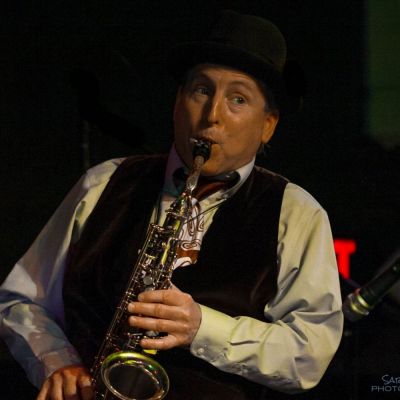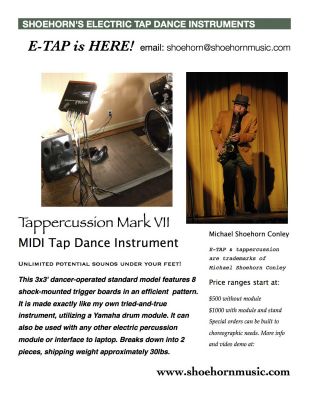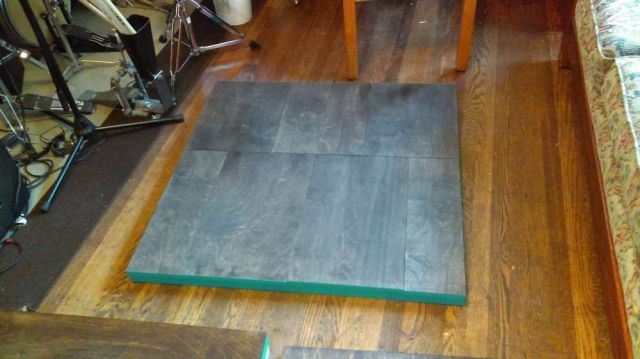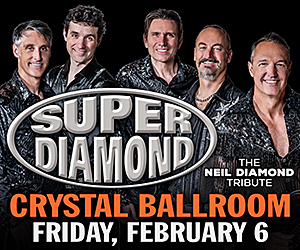Home > News
06/04/2019
Shoehorn's Introduction to Electronic Tap Dancing: MIDI Triggering / Part 1
by MICHAEL 'SHOEHORN' CONLEY // How Shoehorn does what he does, and how you can learn how to make it happen.
In the 20 years since I wrote the following article (in 2 parts) I have gone from experimenting with e-tap in my practice space and on special gigs to doing over a thousand shows with the system I settled on, which I call the Tappercussion™ Mark VII, it being my 7th design prototype. It has become a standard part of my stage set, sets up in minutes, and features 8 shock-mounted trigger boards controlling a Yamaha drum module.
I can scroll rapidly between “kits”,(groups of 8 sounds & or pitches), rapidly enough to play chord changes when desired. I can select sounds such as steel pan or vibraphone, and set pitches for each trigger channel. So that can be 8 notes of a scale or a 4-note chord doubled. I can trigger drones or drum loops as well as a wide variety of drum sets and percussion such as conga and tabla, bass guitar, or many novelty sounds.
There is the option of sampling particular custom sounds and triggering those. Another fascinating possibility is hooking the trigger module to a computer running a professional software program called Abelton Live, which offers stunning virtual instrument sounds and advanced manipulation of the sound processing.
I have released several CDs featuring the Mark VII, starting with Trio Calzador in 2003, and both Café Cirque and The Blue Monk in 2008, the latter a recording of a 2006 performance at the Blue Monk jazz club. In 2015 I released a DVD titled Dances With Instruments which is also available as a playlist on my youtube channel. The DVD includes a “how-to” segment on crafting a Mark VII for the DIY enthusiast. I have other demonstration videos showing the capabilities of the instrument as well as live performances published on the channel.
I have also sold a small number of these instruments on special order. I will soon be offering a 2-trigger model which will avail tap dancers of some of the newer electronic drumming products featuring only one or two inputs. I believe this simple model would be a great addition to many solo performers, from one-man-bands to singing guitarists or even certain circus performers.
I am sure I have a lot more to say on the topic, but in republishing the 2 parts of the original article on Oregon Music News, I hope to preserve the lore and history of this branch of the art form and acquaint audiences, and especially, performers who will take this to the next level.
One of the key attractions of tap dancing to me is that it can be a form of self-accompaniment, whether for a singer or an instrumentalist such as myself, or other varieties of performers, such as jugglers and acrobats. I believe my e-tap™ instruments open up unlimited possibilities in this area.
One technical note for readers in 2019. MIDI cables have largely been replaced by USB connections on modern sound equipment. Another thing is that some of the applications I envisioned are much more in reach of today’s performers due to the huge variety of gadgetry and devices now available.
I welcome opportunities to make myself available in a consulting or mentoring role, and indeed I have many more ideas for utilizing this gear than I have been able to realize in my own performing and studio work.
The following articles originally appeared in 1999 and 2000 in On Tap, the International Tap Dance Association newsletter.
The purpose of this short article is to acquaint readers with some basic theory and knowledge of electronic tap. I feel the potential for this medium to be limitless due to the variety of sounds that can be used. All the electronic components are readily available in music stores and can be applied to tap dancing by simply applying the pickups, or triggers, to the surface being danced upon. The reader will have to construct (or have built) the actual triggering surface according to individual requirements.
This can be as simple as a slab of wood ( TAP DOGS ), or as elaborate as a giant marimba. My method includes the natural tap sound in the mix. Other methods utilize triggers built into the shoes, with sounds operated remotely by an engineer (like in the film TAP!) . Either way, the same technology is employed to turn tap dance into electronic percussion music.
It is my feeling that this is an area worthy of much more exploration by the tap dance community, so I am sharing some of my expertise in order to encourage my fellow hoofers to give it a try. By no means am I suggesting we abandon the special sound of acoustic tap, but rather augment it and give it something more, growing out of the existing technique of the artists. I note that I do not use it in the majority of my appearances.
It is possible to get started without a huge budget and a sound technician. In fact, my personal tap instruments* are controlled by me onstage, and were all programmed by myself using factory sounds and MIDI note numbers (60 = middle C on the piano), or analog percussion synths.
The basic component outline of an electronic tap kit:
Tap shoes >wood >trigger >MIDI Interface >sound module >amp
Tap dancing > Wood. The sound of taps on wood is the foundation of my sound. This comes through on it’s own dedicated mics or triggers. Other triggers are mounted on wooden boards which are to be danced upon to generate the electronic sounds.
Wood > Trigger. The wood used for triggerring can be any size: a whole panel of plywood with one trigger or a series of small boards with individual triggers. The choices in this are up to the technical needs and ambitions of the individual choreography. This wood effectively becomes a MIDI controller, the “tap dance instrument”.
Trigger > MIDI interface. Essentially a type of microphone, triggers are the basic component of any electronic tap rig. No matter what kind of electronics you run it through, the tap signal has to be “picked-up” electronically and then converted into electronic sounds chosen by the tap artist, producer, or sound engineer. Triggers may be purchased ready made, or custom made, and are plugged into a MIDI Interface. Keyboards and other devices on the market provide myriad sounds which can be accessed via MIDI (Musical Instrument Digital Interface). A MIDI Interface takes the impulse of the tap and converts it into digital information. This information can be controlled and shaped by the user into desired sounds and pitches. Arrangements of notes can be saved and named, and “dialed in” when needed.
MIDI Interface > Sound Module. There is a wide choice of sound modules. Drum sets, various percussion kits, bass and tuned percussion are among the available factory preset sounds that are built into many MIDI drum modules. Some of these modules have multiple trigger inputs and may be the only thing you need besides your triggers, wood, and some cables. With a sampler, the variety of effects is as limited as the imagination, for one can sample any sound and play it back with one’s feet. Many keyboards of various prices have MIDI in and out and have desirable sounds with triggering potential. Some sound modules have the capability to change their sounds via “sound cards” and discs. A computer with MIDI ports and the correct software is the obvious choice for many artists.
Sound Module > Amp. To hear the sound you are creating with your feet with all this fancy gear you will need a power amp or sound monitor of some sort, whether it be an instrument amplifier or the house P.A. via direct input boxes. For rehearsing, headphones may suffice.
Given sufficient interest, I will provide sequels to this initial article, covering some of the various technical considerations involved in this field. These may include design and construction of the electronic tap dance instrument or MIDI controller, note and voice programming, musical values, sampling, analog and digital effects, composition, choreographic effects, and other choices and technical hurdles that confront the tap synthesist.
Michael “Shoehorn” Conley is a tap dancing saxophone player. He has used his Tappercussion™ electronic tap dance instruments in performances and recordings since 1983. ©1999 Michael “Shoehorn” Conley










